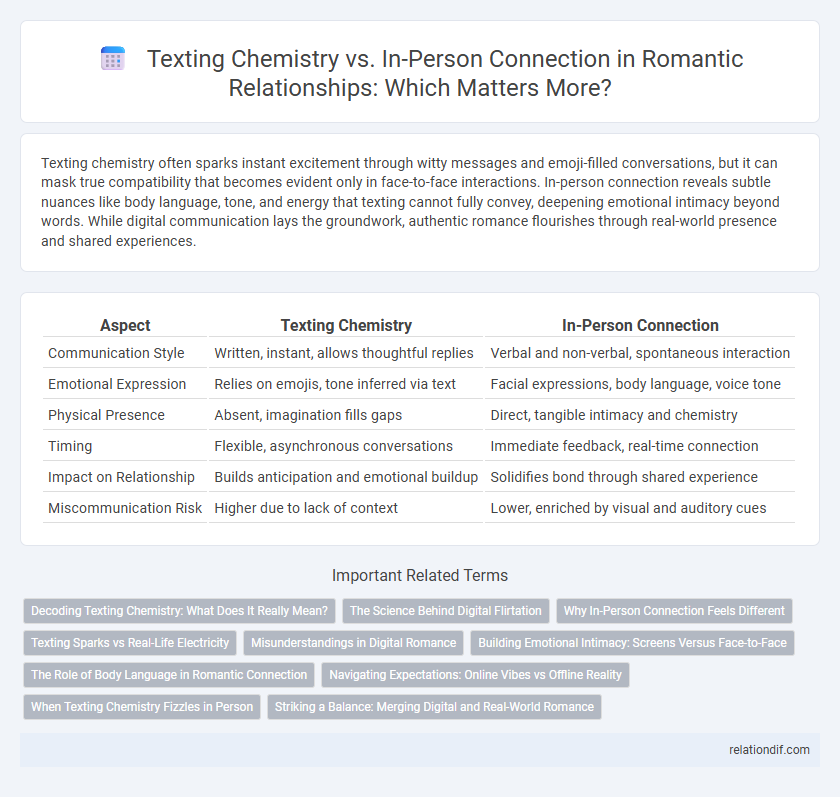Texting chemistry often sparks instant excitement through witty messages and emoji-filled conversations, but it can mask true compatibility that becomes evident only in face-to-face interactions. In-person connection reveals subtle nuances like body language, tone, and energy that texting cannot fully convey, deepening emotional intimacy beyond words. While digital communication lays the groundwork, authentic romance flourishes through real-world presence and shared experiences.
Table of Comparison
| Aspect | Texting Chemistry | In-Person Connection |
|---|---|---|
| Communication Style | Written, instant, allows thoughtful replies | Verbal and non-verbal, spontaneous interaction |
| Emotional Expression | Relies on emojis, tone inferred via text | Facial expressions, body language, voice tone |
| Physical Presence | Absent, imagination fills gaps | Direct, tangible intimacy and chemistry |
| Timing | Flexible, asynchronous conversations | Immediate feedback, real-time connection |
| Impact on Relationship | Builds anticipation and emotional buildup | Solidifies bond through shared experience |
| Miscommunication Risk | Higher due to lack of context | Lower, enriched by visual and auditory cues |
Decoding Texting Chemistry: What Does It Really Mean?
Texting chemistry refers to the seamless flow of conversation, clever wordplay, and emotional resonance experienced through digital messages, often characterized by rapid responses and shared humor. However, this virtual rapport can differ significantly from in-person connection, where body language, tone, and physical presence provide deeper layers of intimacy and understanding. Decoding texting chemistry requires recognizing that strong digital interactions may signal initial attraction but need real-world encounters to validate genuine romantic compatibility.
The Science Behind Digital Flirtation
Texting chemistry often relies on rapid, witty exchanges and the strategic use of emojis to convey tone, activating brain areas associated with reward and anticipation, such as the ventral striatum. In-person connection engages multisensory inputs--body language, vocal tone, and eye contact--stimulating mirror neurons that foster empathy and deepen emotional bonding. Neuroscientific studies reveal that digital flirtation triggers dopamine release, creating excitement, while face-to-face interaction recruits oxytocin pathways, strengthening trust and attachment.
Why In-Person Connection Feels Different
In-person connection feels different because it engages multiple senses simultaneously, such as touch, eye contact, and body language, creating a richer emotional experience than texting alone. Physical presence triggers subconscious cues like pheromones and microexpressions that enhance intimacy and trust, which digital communication often fails to replicate. This multi-sensory interaction fosters a deeper, more authentic bond that texting chemistry cannot fully capture.
Texting Sparks vs Real-Life Electricity
Texting sparks ignite initial attraction through witty messages, emojis, and quick replies, creating a virtual chemistry that feels exciting and engaging. However, real-life electricity involves body language, eye contact, and physical touch, which deepen emotional bonds and reveal authentic connection. While texting can build anticipation, in-person encounters solidify genuine romantic feelings and mutual understanding.
Misunderstandings in Digital Romance
Texting chemistry often suffers from misinterpretations due to the lack of vocal tone, facial expressions, and body language, which are crucial for conveying emotions in romance. Emojis and punctuation cannot fully replace the nuances of in-person interaction, leading to misunderstandings and mixed signals. Digital romance requires greater clarity and patience to bridge the gap between virtual messages and genuine connection.
Building Emotional Intimacy: Screens Versus Face-to-Face
Texting allows for thoughtful expression and frequent interaction, fostering emotional intimacy through consistent communication and shared vulnerability. However, face-to-face connection reveals nonverbal cues and spontaneous reactions, deepening trust and empathy more effectively than screens alone. Combining both digital messaging and in-person encounters creates a balanced foundation for authentic emotional bonds in romantic relationships.
The Role of Body Language in Romantic Connection
Body language plays a crucial role in romantic connection by conveying emotions and intentions beyond words, often intensifying the sense of chemistry felt in person. Nonverbal cues such as eye contact, subtle touches, and facial expressions create a deeper emotional bond that texting alone cannot replicate. This tactile and visual feedback loop enhances mutual attraction and understanding, highlighting the unique dynamics of face-to-face interaction in romance.
Navigating Expectations: Online Vibes vs Offline Reality
Texting chemistry can spark initial attraction through quick wit and playful banter, yet it often lacks the full emotional depth and nonverbal cues found in face-to-face interactions. Navigating expectations requires recognizing that online vibes may exaggerate compatibility or mask true relational dynamics, while offline reality grounds connection in physical presence, body language, and authentic emotional resonance. Balancing these differences fosters realistic romantic anticipation and stronger, more nuanced relationships.
When Texting Chemistry Fizzles in Person
Texting chemistry often creates an illusion of intimacy through witty banter and prompt replies, but it can fizzle in person when nonverbal cues and genuine emotional presence are absent. In-person connection relies heavily on body language, eye contact, and shared energy, elements that texting cannot fully convey. Couples may find that despite vibrant digital exchanges, real-life interactions reveal mismatched temperaments or emotional gaps, highlighting the limitations of online romance chemistry.
Striking a Balance: Merging Digital and Real-World Romance
Texting chemistry helps build anticipation and emotional intimacy through consistent, engaging conversations, while in-person connection offers authentic nonverbal cues and physical presence that deepen emotional bonds. Striking a balance between digital communication and face-to-face interaction creates a more holistic romantic experience, where virtual flirtation complements genuine shared moments. Integrating both channels enhances overall relationship satisfaction by combining immediate responsiveness with meaningful, embodied connection.
texting chemistry vs in-person connection Infographic

 relationdif.com
relationdif.com